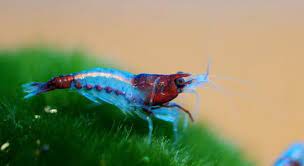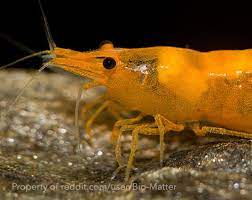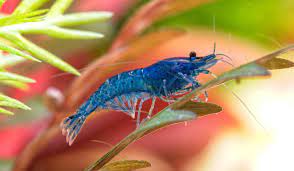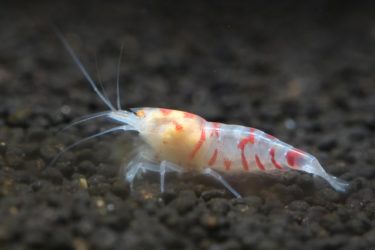In this article, we are going to discuss freshwater shrimp called Neocaridina. These are a group of dwarf shrimp that have the following types, Snowball Shrimp, Blue pearl shrimp, Cherry shrimp, and Yellow shrimp. Continue reading to learn more and more about these species of shrimp.
Table of Contents
General information about Neocaridina shrimp

The easiest type of shrimp for beginner hobbyists is the Cherry shrimp, as the other types are rather difficult to maintain.
The origins of these shrimp come from South-East Asia. They are usually found in ponds and streams, and as natural substrates, they use rocks, plants, and wood.
Neocaridina Overview
Neocaridina shrimps are the smallest and colorful species available in large varieties. Its natural color is green-brown, but nowadays, you may find it in red, orange, violet, green, black, yellow, blue, etc.; the wide range of colors make it a wonderful aquarium species.
Here are a few Neocaridina types which you can have in your aquaria, such as Fire Red Cherry Shrimp, Blue Sky Shrimp, Sakura Red Cherry Shrimp, Bloody Marry Shrimp, Blue Velvet Shrimp, Blue Dream Shrimp, Yellow Shrimp, Orange Shrimp, Yellow Golden Back Shrimp, and snowball Neocaridina. In this guide, we will get complete detail about the Neocaridina.
Towards the end, we will have some commonly asked questions and its explanation in brief.
Neocaridina Appearance
Neocaridina is small in size, and their body is elongated. They have five pairs of walking legs called Pereopods. The first two pairs of legs are modified chelate structures, claw-like appendages utilized to grasp food. The remaining pairs of jaw legs (maxillipeds) are found in front of the pereopods that help Neocaridina feed.
Pleopods are five pairs of arms found beneath the belly and utilized for swimming. These limbs are also deployed to retain eggs in female shrimp. When it comes to the beak, shrimp’s beak is more squared in comparison to the beak of a saltwater shrimp species.
Lifespan Of Neocaridina
The lifespan of Neocaridin varies. Some variety may live up to 8-10 years, but generally, if we talk about the Lifespan of Neocaridina, we can say it is around 1-2 years, or we can say 12-24 months. So here we have brought out a few Neocaridin shrimps lifespan:
Ghost shrimp (Palaemonetes paludosus) has 1-3 years. Amano shrimp (Caridina multidentata) can live from 2 to 5 years. Bamboo fan shrimp (Atyopsis moluccensis) has 6 – 7 years, whereas the lifespan of Cameroon fan shrimp (Atya gabonensis) is about 8 – 10 years.
Neocaridina Size

Let us now discuss the size of Neocaridina. You will find females have sizes larger than males as they carry eggs inside them. The size of a fully-grown and cared male Neocaridina is between three to four centimeters. A fully grown female Neocaridina is around four to five centimeters.
Their size may vary according to the condition they are living in. However, if you give attentively feed them, you can get their maximum size in a short time also.
Neocaridina Tank Mates
If you want to maintain more than simply shrimp, consider that most Neocaridina setups are too tiny to accommodate most tankmates. Almost all fish will capture and consume shrimp fry or adult dwarf shrimp, which is not ideal if you attempt to build a big colony or keep one of the more costly varieties.
Stick to a single species aquarium or a few snails if you want to keep your Neocaridina shrimp completely secure. The Otocinclus species are likewise recognized for their tranquility. Dwarf shrimp species like cherry shrimp, which are very inexpensive and reproduce fast, should do well in densely planted calm community aquariums.
Consider choosing Neocaridina species as their tank mates for good breeding and vibrancy in the tank. Keeping other species might hamper Neocaridina’s movement.
Neocaridina Behaviour And Temperament
The neo shrimp is a non-aggressive species. They can be spotted grazing on biofilm, aquarium decor, or the borders of the tank throughout the day, seeking debris among the gravel, and even mating. Neocaridina shrimp are tranquil and easy to care for species, making a wonderful addition to any aquarium.
They spend the majority of their time foraging and seeking food, causing movement on the tank’s bottom to look very good truly. Pregnant females are frequently seen floating in freshwater over their eggs to provide oxygen. However, they will most likely be hiding under plants or near the back of the tank. They become crazy and could be seen as dancing, but they attempt breeding.
Breeding Neocaridina
Males Neocaridina are generally smaller and less colorful than the female Neocaridina. The male’s tail is thinner since it isn’t used to transport eggs. Although the female is normally bigger and is richer in color, selective breeding might result in males with comparable coloration.
In more translucent individuals, the growing eggs on the ovaries can be seen on the upper region of the female’s torso, on the “shoulder.” The color of their eggs will depend upon the breed of shrimp. The form of the shrimp’s ovaries drapes across both sides, attaining it the moniker “saddle.” The existence of a “saddle” signals that the female is ready to mate.
When neo shrimp are roughly 4–6 months old, they attain sexual maturity. A sexed pair of shrimp require constant water conditions and a food supply for their breeding process. In the female ovaries, the development of eggs can be seen in her “saddle” on the back which has a triangular shape.
When a female Neocaridina becomes mature, she releases pheromones into the water then the male shrimp comes towards the pheromones. After that, male neo shrimp become agitated and swim towards the female. After that, they start mating, and the male shrimp put his sperm into the female shrimp’s body.
When the eggs are fertilized, they come out from the female’s body. Females would again be ready for mating when the old eggs are hatched.
Facts About Neocaridina

Vast variety
You can find several different varieties of Neocaridina. They formed in vast varieties. Some of them are given below:
1. Blue Sky Shrimp
2. Yellow Shrimp
3. Blue Dream Shrimp
4. Sakura Red Cherry Shrimp
5. Bloody Marry Shrimp
6. Blue Velvet Shrimp
7. Yellow Golden Back Shrimp
8. Snowball Neocaridina
9. Orange Shrimp
10. Fire Red Cherry Shrimp
Bright color

Neocaridina shrimps are too bright and attractive that you can forget to see fish. There are found in many colors, but their natural color is green-brown. Their origin was in southeast Asia.
Neocaridina aquarium
The aquarium of Neocaridina must be well maintained; you must provide them with a touch of their natural homes. There should be plants and carpeting in the foreground in an aquarium where they can hide and play. Neocaridina is the day worker shrimp and sleeps at night.
Is Neocaridina Right For You?
Yes, they are for you only. They look extremely beautiful, are of a great colored variety, and effortlessly light up your tank. These freshwater species are most active during the daytime. Therefore, it provides your tank with a unique look.
Frequently Asked Questions
Are Neocaridina Shrimp Easy To Breed?
No such special step is required for Neocaridina shrimp’s breeding. First, you must provide them with natural habitats like the tank’s surroundings and caress them with a proper feeding schedule. Then the stage of breeding will arrive. Naturally, it takes three months for them to start breeding. If you want a brief explanation about their breeding refer to the breeding section above.
What To Feed Your Neocaridina Shrimp?
Neocaridina Shrimps are omnivores. They love to try new varieties of food, they can also find their food from the tank, but if you want to feed them with the market food, you can try the listed foods:
- Vegetables
- Repashy Gel Food
- Hikari Shrimp Cuisine
- Sera Shrimp Natural Sinking Granules
- Xtreme Shrimpee Sinking Sticks
- Fluval Bug Bites Shrimp Formula
- Catappa Leaves
- Zoo Med Nano Banquet Food Blocks
Would It Be Fine To Keep Neocaridina And Caridina In The Same Tank?

They should get along nicely. When it comes to having a Neocaridina and a Caridina in the same tank, the only challenge we can think of is finding two species that prefer the same water conditions. Neocaridina love fairly hard (to extremely hard) alkaline water; those housed in acidic water have shorter lives and reproduce poorly, with shrimplet death rates approaching 100% if your water is too low in the acidic range.
Caridina varies a lot more, but many of the most popular ones require soft, acidic water, and if the pH level rises beyond 7, you’ll observe about 100% shrimplet death. However, Caridina can flourish and spawn in more alkaline conditions, and the Dark Green may be one among them. If that’s the case, you’ve found a winning combination for your shrimp tank.
Maintenance of Neocaridina
It is recommended to keep Neocaridina shrimp in aquariums with a lot of plants and hiding places. The plant not only provides hiding places but also provides enough place for bacteria and algae to live. The algae and other bacteria are the main components in the diet of these shrimp.
Also, it is recommended to keep these shrimp in groups, preferably at least a group of six, otherwise, they will feel shy.
Tank requirements for Neocaridina shrimp
You can keep these shrimp in minimum 15 L aquariums as they are rather small and do not require much space. But if you are going to keep them with other species then you can get a bigger tank.
These shrimp should be kept in super clean water, they have a high nitrite and ammonia intolerance. So even the existence of a little ammonia in the tank can kill the shrimp. To avoid this, the tank of Neocaridina shrimp should be perfectly cycled with filtration. They are also highly intolerant to copper, so whenever you bring a new plant to the tank you need to carefully clean it from copper. Also, you cannot give them medications containing even a small amount of copper, otherwise, the result can again be fatal.
The hardness of the tank water should be a pH of 6.5-8.0. As for the tank water temperature it is recommended to keep it between 18-28°C. With higher temperature water these shrimp breed faster but their lifespan gets shorter because hot water affects their metabolism.
Tankmates for Neocaridina shrimp
If you want the main attention keepers in your tank to be Neocaridina then it is recommended to keep them with other types of dwarf shrimp and snails. This way you will be able to see more of their character.
But if you want to keep them with fish, then you need to get smaller fish that will not eat the shrimp. You can get plant-eater fish. You can also keep small Corydoras and small types of catfish that will not be dangerous to keep with Neocaridina.
Diet of Neocaridina
Feeding Neocaridina shrimp is pretty easy, as they eat almost everything. They spend their time looking for foods like algae on the surface of the water. Even though they get food naturally you still can feed them daily. You can get food made for shrimp or you can feed them with small pieces of vegetables.
How to breed Neocaridina shrimp?

There is nothing special that you should do to breed Neocaridina, if the shrimp are healthy they will breed naturally. When they are ready for breeding, female shrimp release pheromones into the water to let males know that they are ready for mating. Also, another way to know that the female is ready for breeding is the coloring at their shoulder height. You can see the immature eggs inside the shrimp. When the female shrimp gets fertilized by the male the eggs get to the female abdomen where the female shrimp will keep them until they will get hatched. The eggs are hatched after 3 weeks of fertilization.
After the eggs are hatched the Neocaridina shrimp do not show any parental care. If you are going to keep the newborn shrimp with fish then it is recommended to have a lot of plants and other hiding places for the newborns, as they are very small and vulnerable. Also, you should be careful to provide high-quality water with the right temperature for the newborn shrimp.
What can cause Neocaridina shrimp to die?
Let’s discuss a few most common reasons that can cause death to Neocaridina. The main cause is old age. Usually, these shrimp live 12-18 months and people get surprised when they die, but no unfortunately they have a very short lifespan. Another common cause can be poisoning from copper. This can happen while adding new plants to the aquarium. Failure during moulting period can also cause death for the Neocaridina shrimp.
This can happen when the shrimp lacks iodine or calcium in their food. So if you often have had these types of a situation consider adding more of these to the diet of your other Neocaridina shrimp. Bad water quality can also cause Neocaridina to die. For instance, even if a small amount of ammonia appears in the water, this can be fatal for the shrimp. And finally, another reason that can cause Neocaridina shrimp to die is being “bullied” by their tankmates.
Overall specifications
- pH: 6.8-8.0
- Temperature: 18-28°C
- Hardness range: 8-20 dkh
- Tank size: min. 15 L
So, overall we have tackled everything regarding the care of Neocaridina shrimp. As we can see these shrimp are pretty easy to keep in a tank especially for new hobbyists as they do not require any specific care. You just need to provide them with the right quality water and a lot of places for hiding. Also, you should be careful to keep them with smaller tank mates for their safety. As for the breeding, as we have mentioned above it is very easy to breed these shrimp. So, for those looking forward to breeding their shrimp, you do not have to do anything, if you have healthy shrimp they will do everything naturally. Hopefully, this article was helpful and you learned a lot of information about Neocaridina shrimp.
Conclusion
The conclusion is that Neocaridina shrimps have brightened colors and look adorable. It could be difficult for beginners, but we can easily take good care of their growth rate and enjoy their movements with time. You’ll witness them dancing, playing, eating the most, and breeding in the tank. So what’s stopping you from getting a Neocaridina for your tank?
No related posts.
